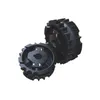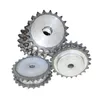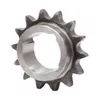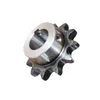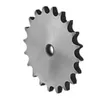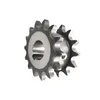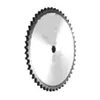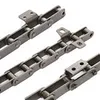Welcome to our comprehensive guide on Sprockets, the essential components for power transmission in various mechanical systems. With decades of engineering excellence, we provide high-quality sprockets designed for durability, efficiency, and reliability. Whether you're in manufacturing, automotive, or industrial applications, our sprockets ensure smooth operation and long service life.
Our sprockets come in a range of specifications to meet diverse needs. Below is a table summarizing the key parameters for our standard models.
| Model Number | Pitch (inches) | Number of Teeth | Bore Size (inches) | Material | Max RPM | Weight (lbs) |
|---|---|---|---|---|---|---|
| SPR-1020 | 0.5 | 20 | 1.0 | Carbon Steel | 3000 | 2.5 |
| SPR-1040 | 0.625 | 40 | 1.5 | Stainless Steel | 2500 | 4.8 |
| SPR-1060 | 0.75 | 60 | 2.0 | Alloy Steel | 2000 | 7.2 |
| SPR-1080 | 1.0 | 80 | 2.5 | Carbon Steel | 1500 | 10.5 |
These parameters ensure compatibility with various chain drives and machinery. Custom sizes and materials are available upon request to suit specific applications.
Sprockets are widely used in numerous industries for transmitting rotary motion between shafts. Common applications include conveyor systems, bicycles, motorcycles, industrial machinery, and agricultural equipment. Their ability to handle high torque and provide precise movement makes them indispensable in modern engineering.
What is a sprocket and how does it differ from a gear?
A sprocket is a wheel with teeth that mesh with a chain or track to transmit motion, whereas a gear meshes directly with another gear. Sprockets are typically used with chains for power transmission over longer distances, while gears are for shorter distances and higher precision.
How do I choose the right sprocket for my application?
Select a sprocket based on factors like pitch (distance between teeth), number of teeth, bore size, material compatibility with your chain, and the operating environment (e.g., exposure to moisture or chemicals). Consult our parameter table or contact our support team for personalized recommendations.
What maintenance is required for sprockets?
Regular maintenance includes lubricating the chain and sprocket interface, checking for wear on teeth, and ensuring proper alignment. Replace sprockets if teeth become hooked or worn beyond acceptable limits to prevent chain slippage and system failure.
Can sprockets be used in high-temperature environments?
Yes, but material selection is crucial. Stainless steel or heat-treated alloy sprockets are recommended for high-temperature applications as they offer better resistance to thermal expansion and degradation.
Are custom sprockets available, and what is the lead time?
We offer custom sprockets tailored to specific requirements, including unusual sizes, materials, or tooth profiles. Lead times vary based on complexity but typically range from 2-4 weeks for standard custom orders. Contact us for a detailed quote.
How do I install a sprocket correctly?
Ensure the shaft is clean and free of debris, align the sprocket with the keyway, and secure it using appropriate fasteners like set screws or locking collars. Always follow the manufacturer's torque specifications and check alignment with connected components to avoid misalignment issues.
What are the signs of a failing sprocket?
Common signs include unusual noise during operation, visible wear or deformation of teeth, chain skipping, and increased vibration. Regular inspections can help detect these issues early and prevent costly downtime.
Do you provide international shipping for sprockets?
Yes, we ship globally with various options for delivery speed and cost. Orders are processed within 1-2 business days, and shipping times depend on the destination. Check our website for detailed shipping policies and rates.
For more technical details, installation guides, or to place an order, visit our product pages or download our catalog. Our team is always ready to assist with expert advice and support to ensure you get the best performance from your sprockets.
